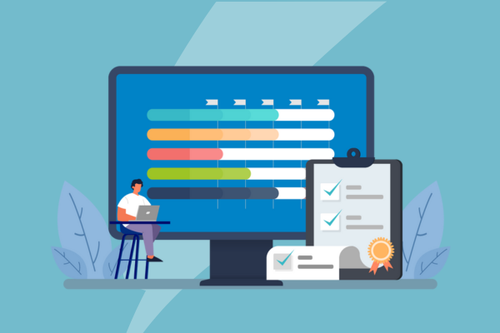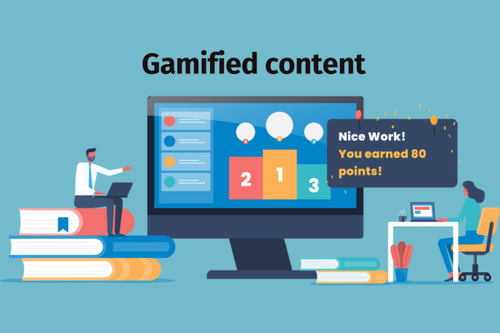Gamification brings forth opportunities to make learning more enjoyable and memorable. By tapping into instant gratification, gamification provides a sense of reward and value that the content otherwise may not deliver. So if you’re finding your learners are disengaged, gamification could be your solution to bringing back excitement and engagement with the content. In this blog post, we'll cover gamification and how you can use it in eLearning to support your learners.
What is gamification?
Gamification adds game-like elements such as point scoring, competition, and badges to non-game environments to increase participation, motivation, and engagement. Game-like elements increase the enjoyment of the task by tapping into intrinsic motivations. For example:
- challenges
- competition
- feedback
- resource acquisition
- rewards
- winning.
In fact, gamification is used in many areas of life, so you may have already encountered it without realising. Below are some examples of gamification:
- Fitness watches: When using a fitness watch to record your step count, there is a reward once the goal is achieved. So you get satisfaction from reaching your step goal and recognition through a badge.
- Habit tracking apps: These apps give you a place to record your new habits, and there is a strong incentive to keep adding to your winning streak by sticking to the habit.
- Loyalty cards: For instance, your local coffee shop might offer a free coffee for every ten coffees you buy. Knowing you're working towards a reward adds more of an incentive, as with each purchase, you’re a step closer to your free coffee.
What is gamification in eLearning?

Gamification in eLearning transforms traditional methods of learning into engaging experiences. The gamified elements provide attainable goals for learners to reach for and a fun experience to help motivate them. Gamification has clear and achievable goals, and dopamine is released in response to accomplishing each goal. Dopamine is a chemical messenger that acts on areas in the brain to produce feelings of pleasure, satisfaction and motivation. Game-like elements can make learning more immersive and increase participation by tapping into learners’ competitive spirit.
You can incorporate gamified elements into your Learning Management System (LMS) content in several ways:
- Points show progression or improvement. You can customise how these work for your learners. For example, you can set up a framework for getting points if questions are answered or tasks are completed correctly.
- Prizes can be given for accomplishing different tasks, such as adding the most glossary entries.
- Badges are similar to prizes and are symbols for showcasing achievement. For instance, completing a certain area of a course.
- Leaderboards can be tailored to whatever competency you wish to reflect. For example, you can use a leaderboard to rank experience or show the best performers for the week.
- Feedback can be visual to show learners their progression. For instance, using a progress bar to show how much of the course content they’ve covered.
- Teamwork can build interpersonal connections between your learners as they work to achieve a common goal. It can also tie into a leaderboard and prizes.
Receiving recognition in gamified LMS content provides learners with a record of their learning and a sense of achievement. Plus, as an educator, you have a quick overview of their course progress.
How do I add gamification to my eLearning?

1. Understand your course objectives
There are many ways you can incorporate gamification into your eLearning content. The first step to successful gamification is to identify your course learning objectives. Starting with learning objectives means there is a clear direction for the course content. For example, you may want to boost engagement and interactions from your learners. Take the time to understand your learners and consider what approaches would be the most effective for them. Does competition motivate your learners? What other elements of gamification might best suit them? For instance, if you’re using points, what would the points track? Then, consider how gamifying your LMS content will enhance the experience and achieve your learning objectives.
2. Start small
As you introduce gamified elements to your LMS software, start small and test what works for your learners. You could begin by trying out points to see if they’re having the desired effect on learning. Don’t introduce too many new elements at once, as this can make it difficult to determine the effects of gamification. Instead, focus on a balance of gamified LMS content and non-gamified elements, so it’s easier to identify which factors are contributing to trends.
3. Partner for support if needed
It can take time to understand what works best for your learners, and if you don’t have the in-house expertise, you can partner with an experienced instructional designer.
How can the success of gamified LMS content be measured?
Begin by setting up metrics in your LMS software and tapping into your LMS analytics. There are a few ways you can review if your gamified elements are working.
Use quizzes to confirm understanding
You can choose how often you’d like the quizzes to run ‑ they could be random, at the end of each day or at the end of each course.
Review questions at a granular level
Some LMSs such as Moodle and Tōtara have the option to use the ‘response history’ to identify trends of where learners are getting stuck or are spending more time on particular questions. If you’re seeing a pattern, it might suggest that a different approach is needed for that content.
Compare the results to when you’ve run the course without gamified content
In Moodle and Tōtara, you can use the ‘Activity results block’ to review the top grades for your gamified course. Then run the report on a previous version of the course to see if the results differ.. You can also run an ‘Activity report’ for each course to compare the difference in views. Higher views could suggest stronger engagement with the content.
Review participation rates
In Tōtara you can use ‘participation reporting’ and in Moodle the ‘participation report’ to identify which learners are completing which activities.
Observe results
Are you seeing your learners apply what they’ve learnt from the gamified content in other courses? Have grades or results changed for individual learners? If you’re seeing increased engagement but results are stagnant or dropping, there could be too big of a focus on the game elements.
Get feedback from your learners
Gamified content isn’t going to work for everyone, especially if competition doesn’t motivate them. So get feedback from your learners to understand what's working for them individually. You can do this through surveys and individual or group conversations. If gamified elements aren't working for everyone, you can offer course content in other formats to suit their needs.
Discuss outcomes with your staff or managers
You won’t necessarily have insight into how your learners are using what they’ve learned. So check with your fellow staff or your learners’ managers to see what changes they’ve noticed. Engaging with your colleagues can help you understand the retention of new learning and how it is applied.
Where can I get eLearning content development support?
When developing gamified LMS content, remember to tie everything back to your learners and your learning objectives to set them up for success. If you don’t have the resources or the in-house expertise to explore gamification in eLearning, the experts at Catalyst can help. At Catalyst, our instructional designers work to understand your learners’ unique needs and enhance their learning experience. Our team will work to find the best solution for your learners, from gamified content to microlearning to video-based learning, and more. To learn more about our LMS content development services, contact us today.